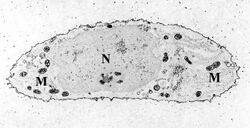Biology:Nuclear calcium

The concentration of calcium in the cell nucleus can increase in response to signals from the environment. Nuclear calcium is an evolutionary conserved potent regulator of gene expression that allows cells to undergo long-lasting adaptive responses. The 'Nuclear Calcium Hypothesis’ by Hilmar Bading describes nuclear calcium in neurons as an important signaling end-point in synapse-to-nucleus communication that activates gene expression programs needed for persistent adaptations.[1] In the nervous system, nuclear calcium is required for long-term memory formation, acquired neuroprotection, and the development of chronic inflammatory pain.[2][3][4][5] In the heart, nuclear calcium is important for the development of cardiac hypertrophy.[6][7] In the immune system, nuclear calcium is required for human T cell activation.[8] Plants use nuclear calcium to control symbiosis signaling.[9]
References
- ↑ Bading, H. (2000-09-01). "Transcription-dependent neuronal plasticity: the nuclear calcium hypothesis". European Journal of Biochemistry 267 (17): 5280–5283. doi:10.1046/j.1432-1327.2000.01565.x. ISSN 0014-2956. PMID 10951185.
- ↑ Weislogel, Jan-Marek; Bengtson, C. Peter; Müller, Michaela K.; Hörtzsch, Jan N.; Bujard, Martina; Schuster, Christoph M.; Bading, Hilmar (2013-05-07). "Requirement for nuclear calcium signaling in Drosophila long-term memory". Science Signaling 6 (274): ra33. doi:10.1126/scisignal.2003598. ISSN 1937-9145. PMID 23652205.
- ↑ Zhang, Sheng-Jia; Zou, Ming; Lu, Li; Lau, David; Ditzel, Désirée A. W.; Delucinge-Vivier, Celine; Aso, Yoshinori; Descombes, Patrick et al. (2009-08-01). "Nuclear calcium signaling controls expression of a large gene pool: identification of a gene program for acquired neuroprotection induced by synaptic activity". PLOS Genetics 5 (8): e1000604. doi:10.1371/journal.pgen.1000604. ISSN 1553-7404. PMID 19680447.
- ↑ Simonetti, Manuela; Hagenston, Anna M.; Vardeh, Daniel; Freitag, H. Eckehard; Mauceri, Daniela; Lu, Jianning; Satagopam, Venkata P.; Schneider, Reinhard et al. (2013-01-09). "Nuclear calcium signaling in spinal neurons drives a genomic program required for persistent inflammatory pain". Neuron 77 (1): 43–57. doi:10.1016/j.neuron.2012.10.037. ISSN 1097-4199. PMID 23312515.
- ↑ Bading, Hilmar (2013). "Nuclear calcium signalling in the regulation of brain function". Nature Reviews Neuroscience 14 (9): 593–608. doi:10.1038/nrn3531. PMID 23942469.
- ↑ Higazi, Daniel R.; Fearnley, Claire J.; Drawnel, Faye M.; Talasila, Amarnath; Corps, Elaine M.; Ritter, Oliver; McDonald, Fraser; Mikoshiba, Katsuhiko et al. (2009-02-27). "Endothelin-1-stimulated InsP3-induced Ca2+ release is a nexus for hypertrophic signaling in cardiac myocytes". Molecular Cell 33 (4): 472–482. doi:10.1016/j.molcel.2009.02.005. ISSN 1097-4164. PMID 19250908.
- ↑ Guatimosim, Silvia; Amaya, Maria Jimena; Guerra, Mateus T.; Aguiar, Carla J.; Goes, Alfredo M.; Gómez-Viquez, Norma Leticia; Rodrigues, Michele A.; Gomes, Dawidson A. et al. (2008-08-01). "Nuclear Ca2+ regulates cardiomyocyte function". Cell Calcium 44 (2): 230–242. doi:10.1016/j.ceca.2007.11.016. ISSN 0143-4160. PMID 18201761.
- ↑ Monaco, Sara; Jahraus, Beate; Samstag, Yvonne; Bading, Hilmar (2016-10-24). "Nuclear calcium is required for human T cell activation" (in en). J Cell Biol 215 (2): 231–243. doi:10.1083/jcb.201602001. ISSN 0021-9525. PMID 27810914. PMC 5084645. http://jcb.rupress.org/content/215/2/231.
- ↑ Oldroyd, Giles E. D.; Downie, J. Allan (2006-08-01). "Nuclear calcium changes at the core of symbiosis signalling". Current Opinion in Plant Biology 9 (4): 351–357. doi:10.1016/j.pbi.2006.05.003. ISSN 1369-5266. PMID 16713329.
 |

